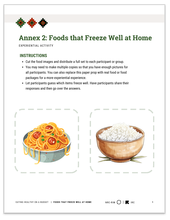
Introduction | Part 1 | Part 2 | Part 3
Part 1: Typical Foods and Healthy Cooking
The first two modules give participants an overview of the food landscape in the United States and the importance of good nutrition. Experiential activities will guide participants as they choose fruits and vegetables to incorporate into their diets, learn about portion sizes, discover which foods freeze well at home, and bake using healthier sugar and fat substitutes.
The modules will end with a recipe for Shorba and a story about Rabia, who remembers eating this healthy stew back home in Afghanistan with her family.
This introductory lesson focuses on creating rapport with participants, getting to know their local food system, and building awareness of healthy eating and how it can prevent diet-related disease. After this lesson, participants will be able to understand concepts such as highly-processed food, hypertension and diabetes, and name 6 nutrition tips. Key learnings include:
- Nutrition tips
- Diabetes
- Hypertension
- Processed food and fast food
For Facilitators
This lesson focuses on tips for staying healthy in the United States by cooking more at home. Participants will learn to recognize foods with many additives so that they can make healthier choices when they shop. They will also share healthy recipes and learn quick tips for making traditional meals healthier by reducing salt, sugar, and oil.
After this session, participants will be able to apply nutrition recommendations to their own food practices based on the previous lesson. They will explore healthy recipes as a group, identify ways to modify recipes to make them more nutritious, and engage their children in cooking for intergenerational benefits.
Key learnings include:
- Avoiding additives & preservatives
- Health benefits of cooking
- Reducing oil, salt, sugar











